Thousands of Induced Earthquakes per Month in West Texas Detected Using EQCCT
Abstract
:1. Introduction
2. Dataset
3. Method
3.1. EQCCT
3.2. Association
3.3. Initial Location
3.4. Refined Location
3.5. Magnitude Estimation
3.6. Relocation
4. Results
4.1. Event Distribution
4.2. Picking and Location Examples
4.3. Initial and Secondary Location
4.4. Relocation
5. Discussion
5.1. Seismotectonic Implications
5.2. Spatiotemporal Correlation with Injections
5.3. Future Development
6. Conclusions
Author Contributions
Funding
Data Availability Statement
Conflicts of Interest
References
- Frohlich, C.; Davis, S.D. Texas Earthquakes; University of Texas Press: Austin, TX, USA, 2003. [Google Scholar]
- Frohlich, C.; Hayward, C.; Stump, B.; Potter, E. The Dallas–Fort Worth earthquake sequence: October 2008 through May 2009. Bull. Seismol. Soc. Am. 2011, 101, 327–340. [Google Scholar] [CrossRef]
- Justinic, A.H.; Stump, B.; Hayward, C.; Frohlich, C. Analysis of the Cleburne, Texas, earthquake sequence from June 2009 to June 2010. Bull. Seismol. Soc. Am. 2013, 103, 3083–3093. [Google Scholar] [CrossRef]
- Frohlich, C.; DeShon, H.; Stump, B.; Hayward, C.; Hornbach, M.; Walter, J.I. A historical review of induced earthquakes in Texas. Seismol. Res. Lett. 2016, 87, 1022–1038. [Google Scholar] [CrossRef]
- Fan, Z.; Eichhubl, P.; Gale, J.F. Geomechanical analysis of fluid injection and seismic fault slip for the Mw4. 8 Timpson, Texas, earthquake sequence. J. Geophys. Res. Solid Earth 2016, 121, 2798–2812. [Google Scholar] [CrossRef]
- DeShon, H.R.; Hayward, C.T.; Ogwari, P.O.; Quinones, L.; Sufri, O.; Stump, B.; Magnani, M.B. Summary of the North Texas earthquake study seismic networks, 2013–2018. Seismol. Res. Lett. 2019, 90, 387–394. [Google Scholar] [CrossRef]
- Skoumal, R.J.; Kaven, J.O.; Barbour, A.J.; Wicks, C.; Brudzinski, M.R.; Cochran, E.S.; Rubinstein, J.L. The induced Mw 5.0 March 2020 west Texas seismic sequence. J. Geophys. Res. Solid Earth 2021, 126, e2020JB020693. [Google Scholar] [CrossRef]
- Hennings, P.H.; Young, M.H. The TexNet-CISR collaboration and steps toward understanding induced seismicity in Texas. In Recent Seismicity in the Southern Midcontinent, USA: Scientific, Regulatory, and Industry Responses; Geological Society of America: Boulder, CO, USA, 2023. [Google Scholar] [CrossRef]
- Savvaidis, A.; Young, B.; Huang, G.-c.D.; Lomax, A. TexNet: A statewide seismological network in Texas. Seismol. Res. Lett. 2019, 90, 1702–1715. [Google Scholar] [CrossRef]
- Doser, D.; Baker, M.; Luo, M.; Marroquin, P.; Ballesteros, L.; Kingwell, J.; Diaz, H.; Kaip, G. The not so simple relationship between seismicity and oil production in the Permian Basin, west Texas. Pure Appl. Geophys. 1992, 139, 481–506. [Google Scholar] [CrossRef]
- Frohlich, C.; Hayward, C.; Rosenblit, J.; Aiken, C.; Hennings, P.; Savvaidis, A.; Lemons, C.; Horne, E.; Walter, J.I.; DeShon, H.R. Onset and cause of increased seismic activity near Pecos, West Texas, United States, from observations at the Lajitas TXAR seismic array. J. Geophys. Res. Solid Earth 2020, 125, e2019JB017737. [Google Scholar] [CrossRef]
- Grigoratos, I.; Savvaidis, A.; Rathje, E. Distinguishing the causal factors of induced seismicity in the Delaware Basin: Hydraulic fracturing or wastewater disposal? Seismol. Soc. Am. 2022, 93, 2640–2658. [Google Scholar] [CrossRef]
- Skoumal, R.J.; Barbour, A.J.; Brudzinski, M.R.; Langenkamp, T.; Kaven, J.O. Induced seismicity in the Delaware basin, Texas. J. Geophys. Res. Solid Earth 2020, 125, e2019JB018558. [Google Scholar] [CrossRef]
- Gibbons, S.J.; Ringdal, F. The detection of low magnitude seismic events using array-based waveform correlation. Geophys. J. Int. 2006, 165, 149–166. [Google Scholar] [CrossRef]
- Schaff, D.P.; Waldhauser, F. One magnitude unit reduction in detection threshold by cross correlation applied to Parkfield (California) and China seismicity. Bull. Seismol. Soc. Am. 2010, 100, 3224–3238. [Google Scholar] [CrossRef]
- Yoon, C.E.; O’Reilly, O.; Bergen, K.J.; Beroza, G.C. Earthquake detection through computationally efficient similarity search. Sci. Adv. 2015, 1, e1501057. [Google Scholar] [CrossRef] [PubMed]
- Ross, Z.E.; Trugman, D.T.; Hauksson, E.; Shearer, P.M. Searching for hidden earthquakes in Southern California. Science 2019, 364, 767–771. [Google Scholar] [CrossRef] [PubMed]
- Zhu, W.; Beroza, G.C. PhaseNet: A deep-neural-network-based seismic arrival-time picking method. Geophys. J. Int. 2019, 216, 261–273. [Google Scholar] [CrossRef]
- Mousavi, S.M.; Ellsworth, W.L.; Zhu, W.; Chuang, L.Y.; Beroza, G.C. Earthquake transformer—An attentive deep-learning model for simultaneous earthquake detection and phase picking. Nat. Commun. 2020, 11, 3952. [Google Scholar] [CrossRef] [PubMed]
- Saad, O.M.; Huang, G.; Chen, Y.; Savvaidis, A.; Fomel, S.; Pham, N.; Chen, Y. SCALODEEP: A Highly Generalized Deep Learning Framework for Real-time Earthquake Detection. J. Geophys. Res. Solid Earth 2021, 126, e2020JB021473. [Google Scholar] [CrossRef]
- Zhang, M.; Liu, M.; Feng, T.; Wang, R.; Zhu, W. LOC-FLOW: An end-to-end machine learning-based high-precision earthquake location workflow. Seismol. Soc. Am. 2022, 93, 2426–2438. [Google Scholar] [CrossRef]
- Zhang, F.; Wang, R.; Chen, Y.; Chen, Y. Spatiotemporal Variations in Earthquake Triggering Mechanisms During Multistage Hydraulic Fracturing in Western Canada. J. Geophys. Res. Solid Earth 2022, 127, e2022JB024744. [Google Scholar] [CrossRef]
- Hassani, A.; Walton, S.; Shah, N.; Abuduweili, A.; Li, J.; Shi, H. Escaping the big data paradigm with compact transformers. arXiv 2021, arXiv:2104.05704. [Google Scholar]
- Mousavi, S.M.; Sheng, Y.; Zhu, W.; Beroza, G.C. STanford EArthquake Dataset (STEAD): A global data set of seismic signals for AI. IEEE Access 2019, 7, 179464–179476. [Google Scholar] [CrossRef]
- Saad, O.M.; Chen, Y.; Siervo, D.; Zhang, F.; Savvaidis, A.; Huang, G.-c.D.; Igonin, N.; Fomel, S.; Chen, Y. EQCCT: A production-ready EarthQuake detection and phase picking method using the Compact Convolutional Transformer. IEEE Trans. Geosci. Remote Sens. 2023, 61, 4507015. [Google Scholar] [CrossRef]
- Dosovitskiy, A.; Beyer, L.; Kolesnikov, A.; Weissenborn, D.; Zhai, X.; Unterthiner, T.; Dehghani, M.; Minderer, M.; Heigold, G.; Gelly, S.; et al. An image is worth 16x16 words: Transformers for image recognition at scale. arXiv 2020, arXiv:2010.11929. [Google Scholar]
- Ioffe, S.; Szegedy, C. Batch Normalization: Accelerating Deep Network Training by Reducing Internal Covariate Shift. arXiv 2015, arXiv:1502.03167. [Google Scholar]
- Srivastava, N.; Hinton, G.; Krizhevsky, A.; Sutskever, I.; Salakhutdinov, R. Dropout: A simple way to prevent neural networks from overfitting. J. Mach. Learn. Res. 2014, 15, 1929–1958. [Google Scholar]
- Vaswani, A.; Shazeer, N.; Parmar, N.; Uszkoreit, J.; Jones, L.; Gomez, A.N.; Kaiser, Ł.; Polosukhin, I. Attention is all you need. In Proceedings of the 31st Conference on Neural Information Processing Systems (NIPS 2017), Long Beach, CA, USA, 4–9 December 2017; pp. 5998–6008. [Google Scholar]
- Loshchilov, I.; Hutter, F. Sgdr: Stochastic gradient descent with warm restarts. arXiv 2016, arXiv:1608.03983. [Google Scholar]
- Rößler, D.; Becker, J.; Ellguth, E.; Herrnkind, S.; Weber, B.; Henneberger, R.; Blanck, H. Cluster-search based monitoring of local earthquakes in SeisComP3. In AGU Fall Meeting Abstracts; NASA: Greenbelt, MD, USA, 2016; Volume 2016, p. S31E-06. [Google Scholar]
- Ester, M.; Kriegel, H.P.; Sander, J.; Xu, X. A density-based algorithm for discovering clusters in large spatial databases with noise. In kdd; AAAI Press: Menlo Park, CA, USA, 1996; Volume 96, pp. 226–231. [Google Scholar]
- Bratt, S.; Nagy, W. The LocSAT Program; Science Applications International Corporation: San Diego, CA, USA, 1991. [Google Scholar]
- Lomax, A.; Virieux, J.; Volant, P.; Berge-Thierry, C. Probabilistic earthquake location in 3D and layered models: Introduction of a Metropolis-Gibbs method and comparison with linear locations. In Advances in Seismic Event Location; Springer: Berlin/Heidelberg, Germany, 2000; pp. 101–134. [Google Scholar]
- Lomax, A.; Michelini, A.; Curtis, A.; Meyers, R. Earthquake location, direct, global-search methods. Encycl. Complex. Syst. Sci. 2009, 5, 2449–2473. [Google Scholar]
- Trugman, D.T.; Shearer, P.M. GrowClust: A hierarchical clustering algorithm for relative earthquake relocation, with application to the Spanish Springs and Sheldon, Nevada, earthquake sequences. Seismol. Res. Lett. 2017, 88, 379–391. [Google Scholar] [CrossRef]
- Gutenberg, B.; Richter, C.F. Frequency of earthquakes in California. Bull. Seismol. Soc. Am. 1944, 34, 185–188. [Google Scholar] [CrossRef]
- Becken, M.; Ritter, O.; Bedrosian, P.A.; Weckmann, U. Correlation between deep fluids, tremor and creep along the central San Andreas fault. Nature 2011, 480, 87–90. [Google Scholar] [CrossRef] [PubMed]
- Segall, P.; Lu, S. Injection-induced seismicity: Poroelastic and earthquake nucleation effects. J. Geophys. Res. Solid Earth 2015, 120, 5082–5103. [Google Scholar] [CrossRef]
- Heimisson, E.R.; Smith, J.D.; Avouac, J.P.; Bourne, S.J. Coulomb threshold rate-and-state model for fault reactivation: Application to induced seismicity at Groningen. Geophys. J. Int. 2022, 228, 2061–2072. [Google Scholar] [CrossRef]

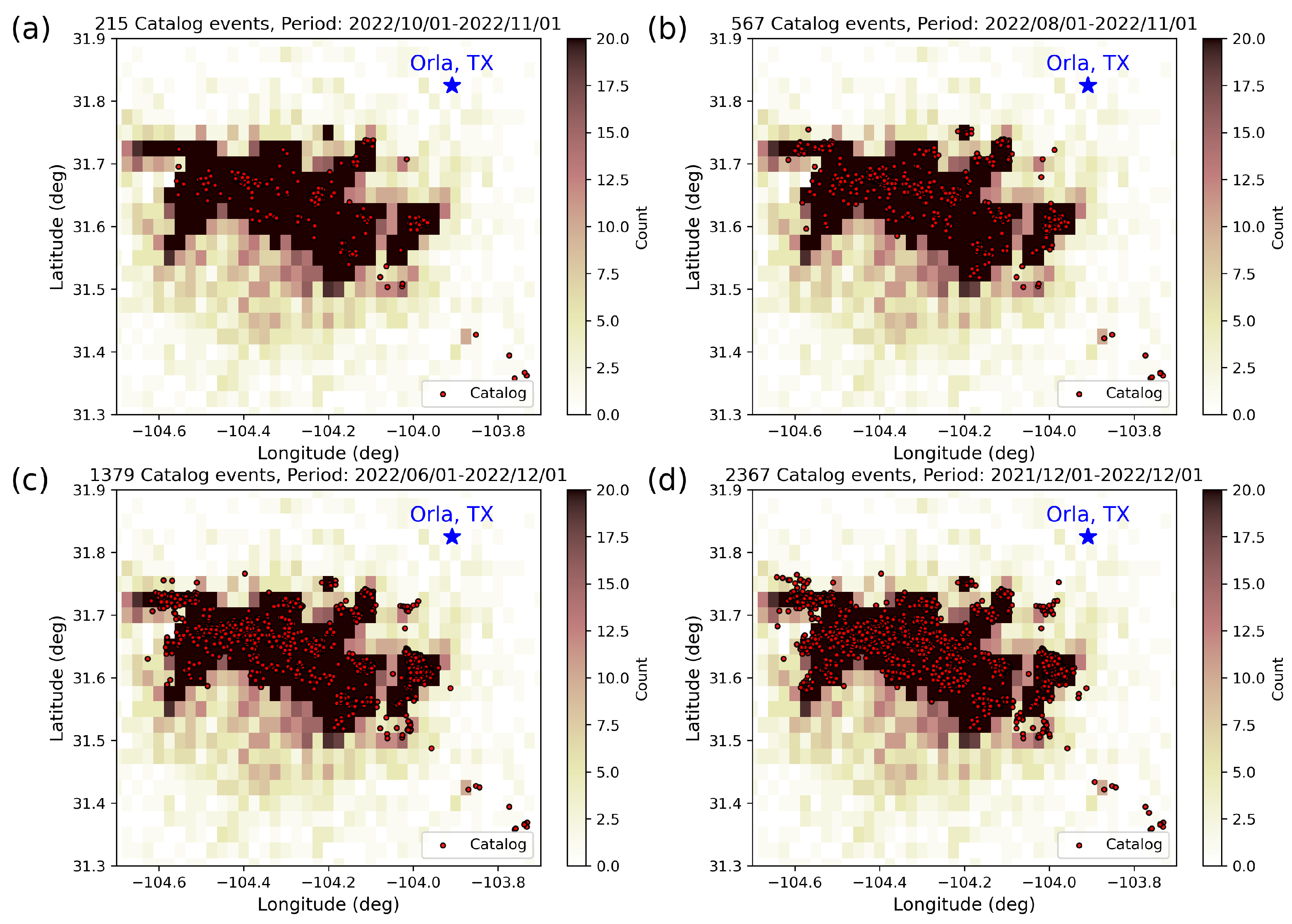
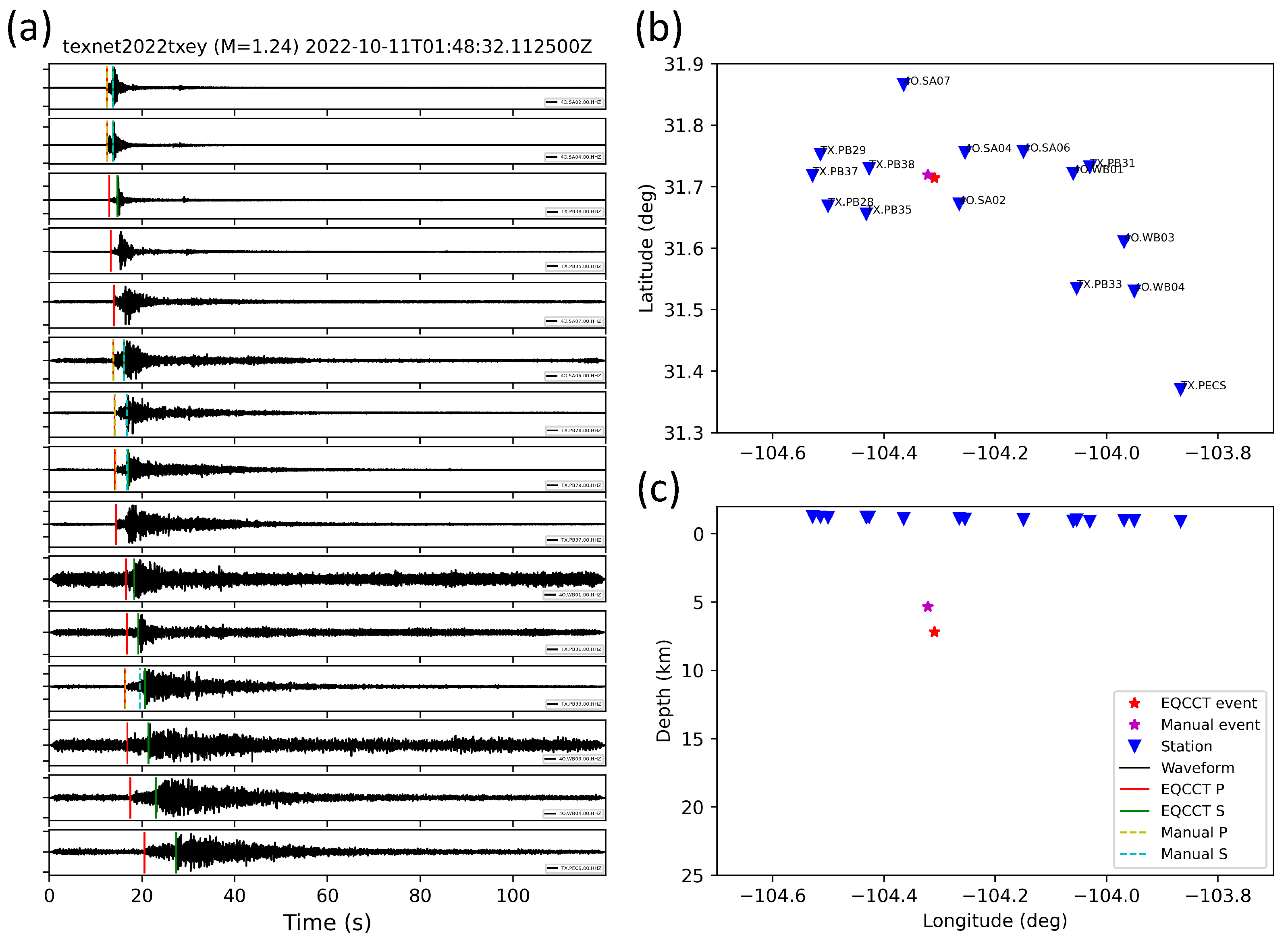
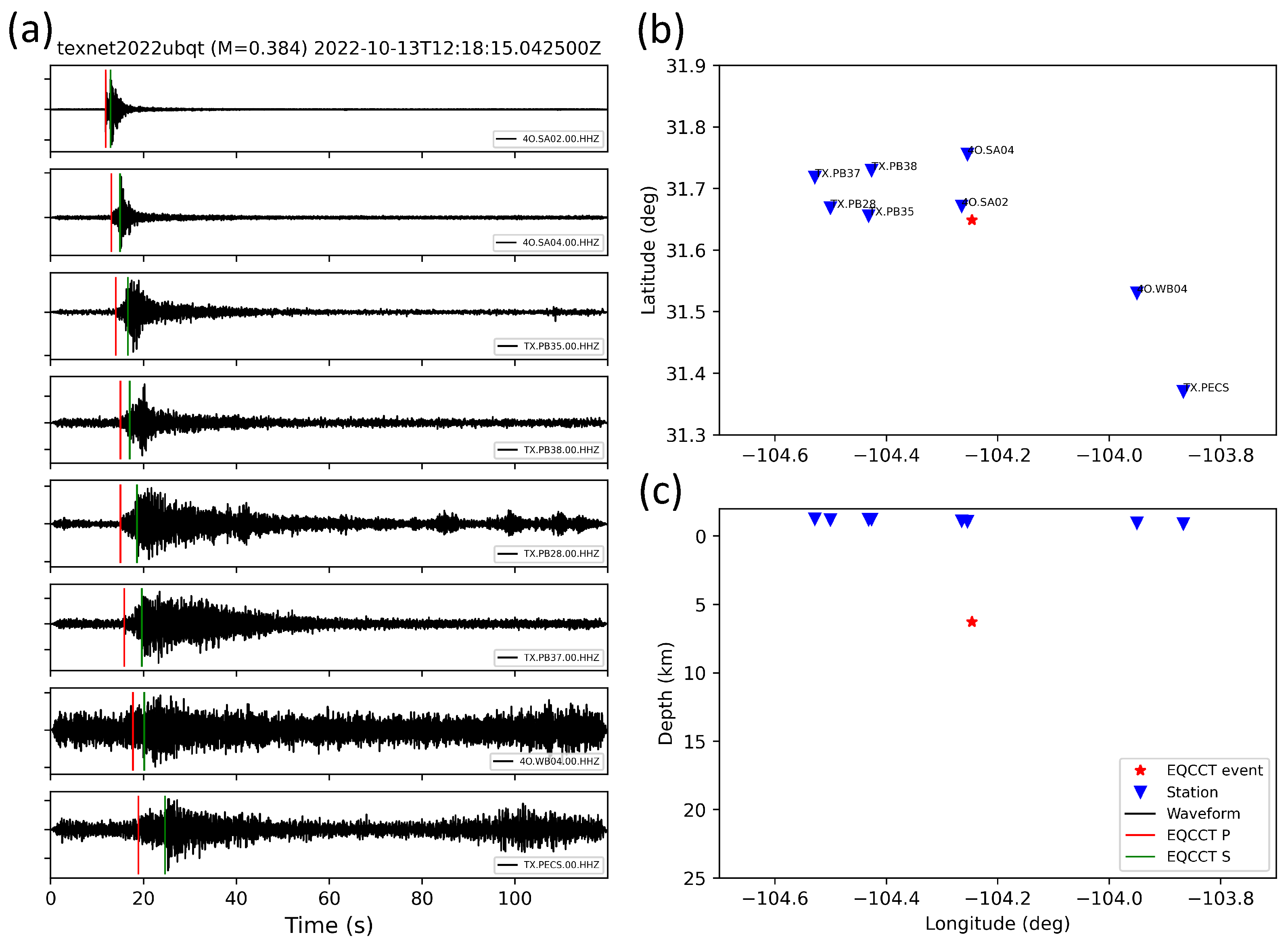
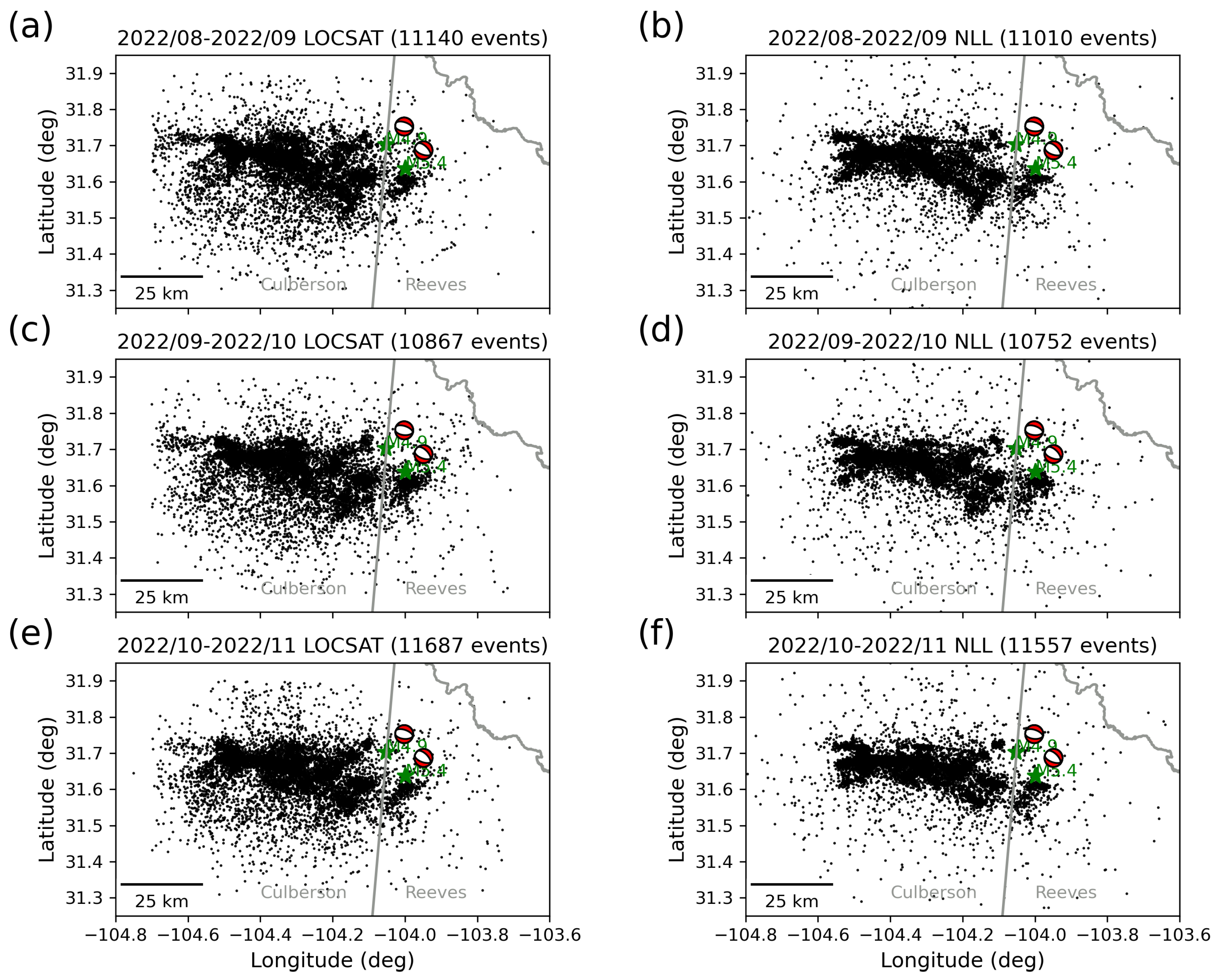

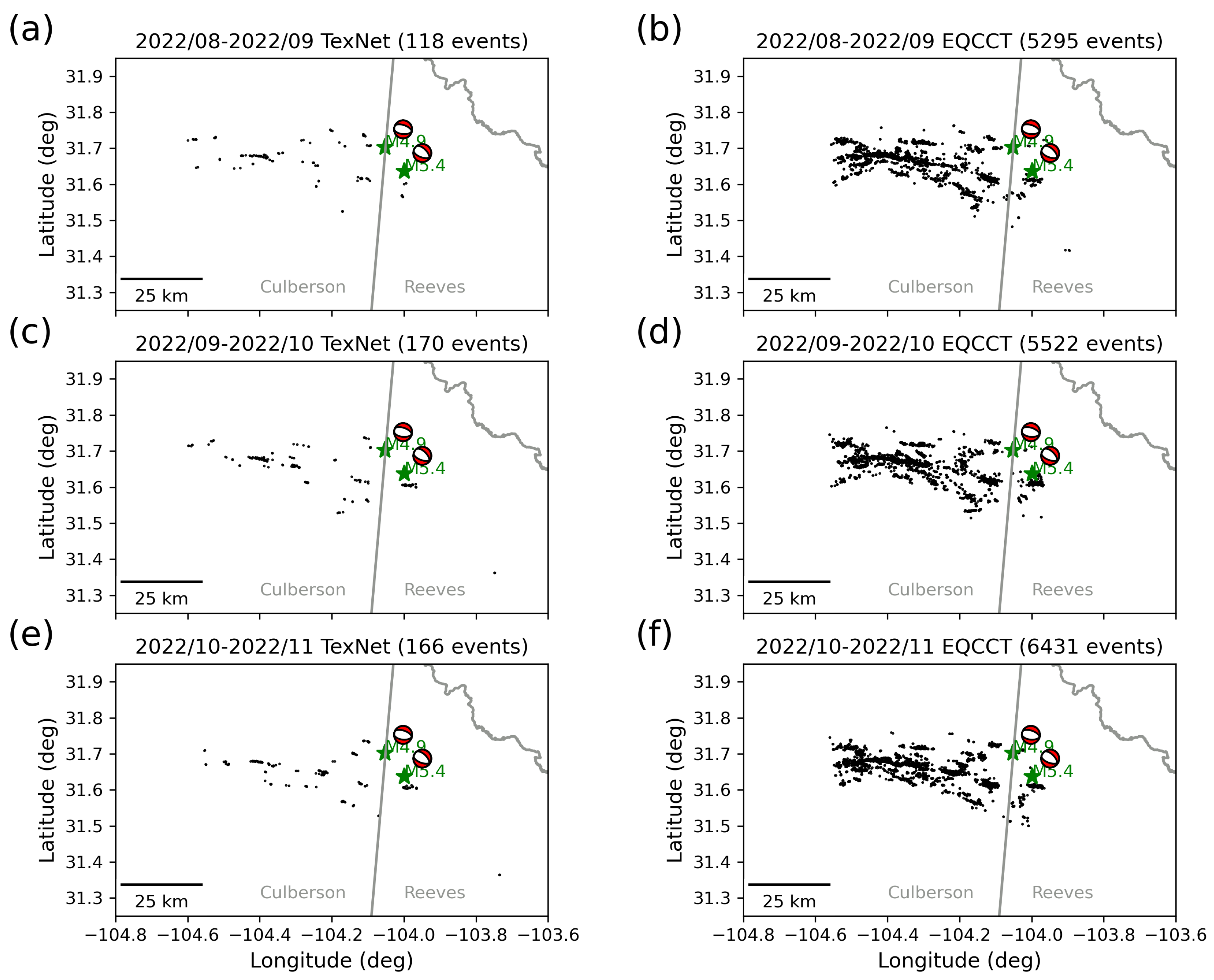
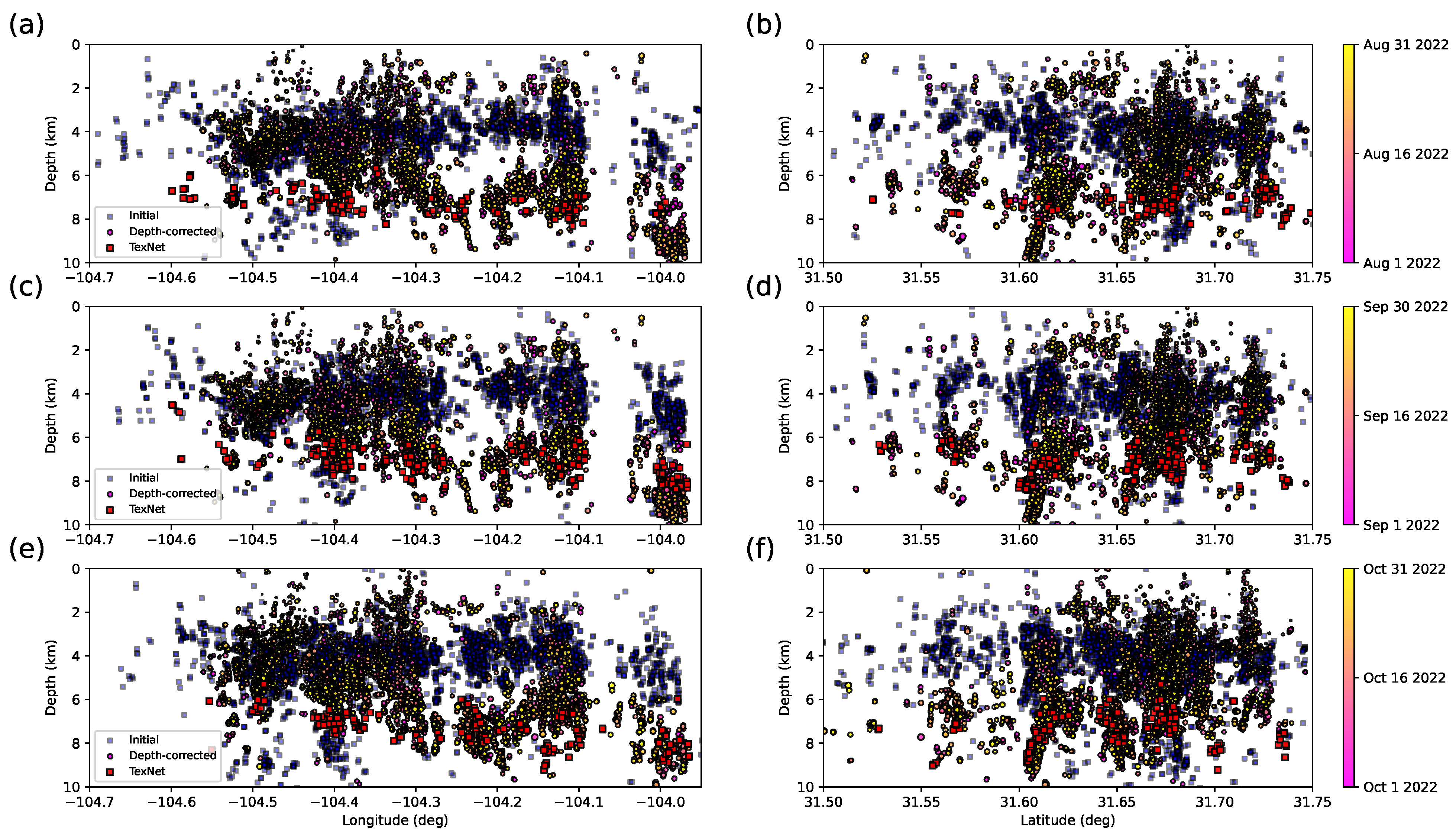
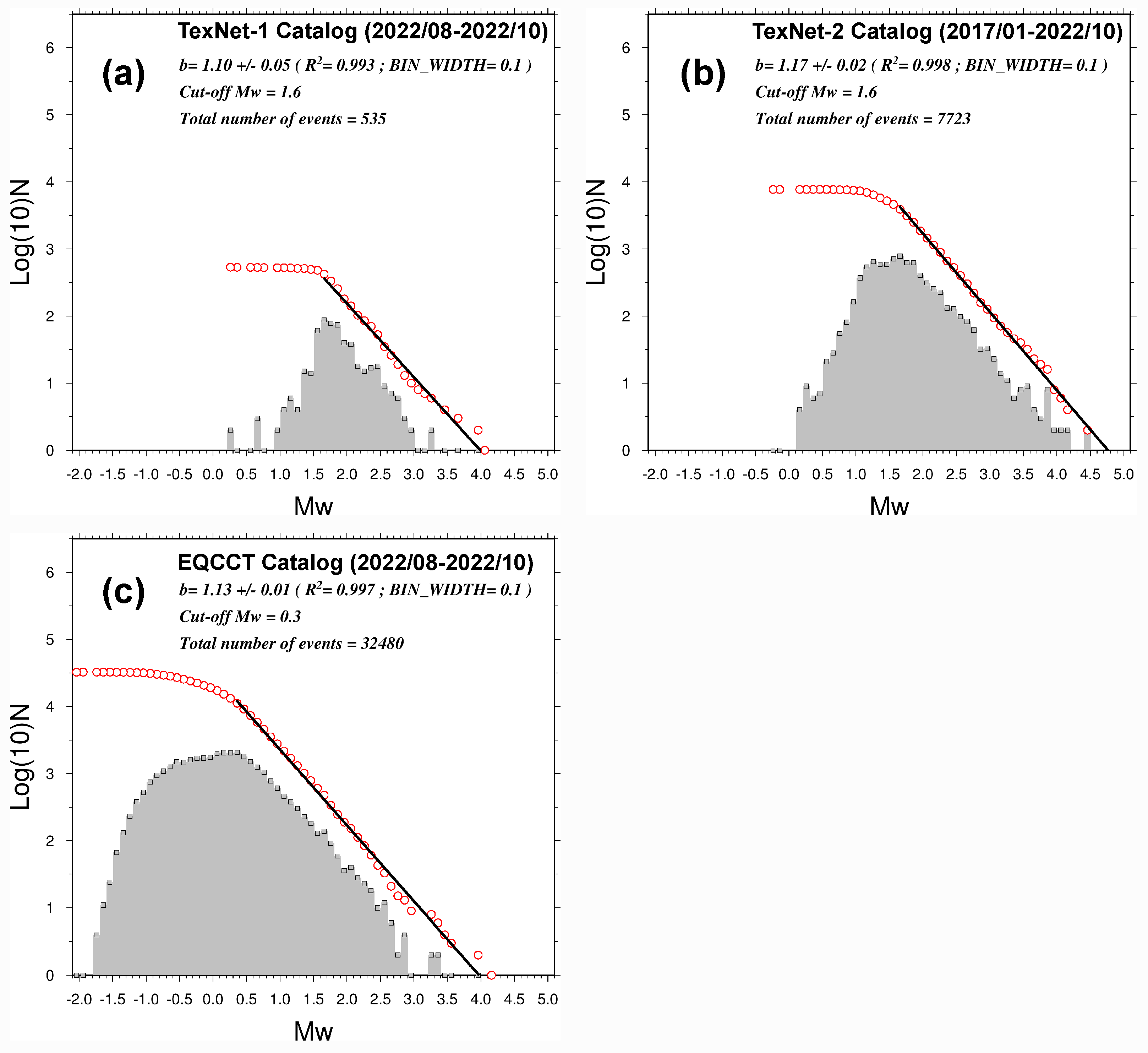

Disclaimer/Publisher’s Note: The statements, opinions and data contained in all publications are solely those of the individual author(s) and contributor(s) and not of MDPI and/or the editor(s). MDPI and/or the editor(s) disclaim responsibility for any injury to people or property resulting from any ideas, methods, instructions or products referred to in the content. |
© 2024 by the authors. Licensee MDPI, Basel, Switzerland. This article is an open access article distributed under the terms and conditions of the Creative Commons Attribution (CC BY) license (https://creativecommons.org/licenses/by/4.0/).
Share and Cite
Chen, Y.; Savvaidis, A.; Saad, O.M.; Siervo, D.; Huang, G.-C.D.; Chen, Y.; Grigoratos, I.; Fomel, S.; Breton, C. Thousands of Induced Earthquakes per Month in West Texas Detected Using EQCCT. Geosciences 2024, 14, 114. https://doi.org/10.3390/geosciences14050114
Chen Y, Savvaidis A, Saad OM, Siervo D, Huang G-CD, Chen Y, Grigoratos I, Fomel S, Breton C. Thousands of Induced Earthquakes per Month in West Texas Detected Using EQCCT. Geosciences. 2024; 14(5):114. https://doi.org/10.3390/geosciences14050114
Chicago/Turabian StyleChen, Yangkang, Alexandros Savvaidis, Omar M. Saad, Daniel Siervo, Guo-Chin Dino Huang, Yunfeng Chen, Iason Grigoratos, Sergey Fomel, and Caroline Breton. 2024. "Thousands of Induced Earthquakes per Month in West Texas Detected Using EQCCT" Geosciences 14, no. 5: 114. https://doi.org/10.3390/geosciences14050114






